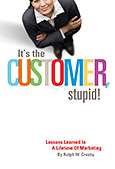Customer-Centric Marketing
— A Lesson Learned from Peter Drucker

Ralph Crosby (left) and Peter Drucker
Way back in 1992 I had the extraordinary opportunity to discuss the customer’s place in marketing with Peter Drucker, an icon acknowledged as the father of modern management. I was interviewing Dr. Drucker as part of a video project for the Drucker Foundation for Nonprofit Management. I chatted with Peter at the Aspen Institute’s Wye Conference Center on Maryland’s Eastern Shore, where he was attending a conference.
Following the interview, Peter and I took a stroll in the Center’s garden. I remember clearly that I wanted to let him know that his philosophy of customer-centric marketing had guided me in my career, so I quoted him my favorite Drucker words on marketing. His response was instantaneous: “Practice of Management, 1954,” he said, recalling the book and date the quote appeared. I half expected him to quote the page number. At the time, Peter Drucker was 85 years old. Talk about “a mind like a steel trap.” To remember that passage out of the 30 plus books he had written seemed to me a remarkable feat. It was also evidence of the importance he placed on marketing.
Peter added something like, “still good today.” And I venture to predict that in the 21st century it will not change. Here’s the passage, which, in my estimation, should be a guiding principal for all marketers, managers, and business leaders:
“Marketing is not only much broader than selling, it is not a specialized activity at all. It encompasses the entire business. It is the whole business seen from the point of view of its final result; that is, from the customer’s point of view.”
Remember, those words were written in the early 1950s when the foundation of marketing was “Sell the product.”
Well, in 2010, product orientation still persists. For example, a Harvard Business Review article on “Reinventing Marketing,” in the January-February 2010 issue, reported that “boards and C-Suites still mostly pay lip service to customer relationships, while focusing intently on selling goods and services.”
From personal experience, I know that the customer often remains an afterthought. I can’t tell you how many business leaders have come to me asking for help in marketing their products but, when I probe, they have a difficult time defining who their customer is and what that customer values and needs. That’s one of the reasons I wrote my new book, “It’s The Customer, Stupid!”
In The Practice of Management, Peter Drucker declared, “The first step toward finding out what our business is, is to raise the question: ‘Who is the customer?’ – The actual customer and the potential customer? Where is he? How does he buy? How can he be reached?”
Putting aside the 1950s’ use of “he” as the generic for both genders, the questions are just as relevant today. Yet, these questions often are missed by the novice marketer, or the novice approaches “customers” too narrowly.
I contend the organization has multiple “customers,” those whose satisfaction is key to the organization’s success. As traditionally seen, they are buyers of products and services. For nonprofit groups they can be contributors; for those offering public service, customers can be volunteers or those who need services; for associations customers can be members; for a hospital they certainly are patients, but they can also be the doctors. In this case, doctors are the kind we call “internal” customers, and these include employees, consultants, suppliers, and others who help an organization succeed.
Looking at it this way, I have always considered that “customers” can be synonymous with “audiences,” “consumers,” “clients,” “stakeholders,” and “target markets.” Therefore, your “customers” may be such targets as government entities or the media.
Even among businesses of a specific type, say a department store, there can be a variety of buying customers, e.g., suit buyers, jewelry purchasers, underwear seekers. Airlines seek passengers, but the coach passenger and first-class passenger are slightly different types of customers. They’re all customers, but they have different wants or needs. Depending on your type of organization, you may have to segment your customer base to meet its different needs.
How do you accomplish that?
The simple answer is “customer information.” You must study your customers’ needs, wants, and preferences to supply what they are seeking. This concept is sometimes characterized as the WIIFM approach, in which the customer figuratively asks “What’s In It For Me?”
This is the classic example of the “customer-centric” rather than the “product-centric” philosophy. It is the customer, not the company, who decides what he or she will buy.
In today’s new media environment, focusing on the customer is more important than ever.
The Internet and social media have lessened marketing’s focus on seeking and selling to customers and has become more about customers seeking the seller. Today the Internet has become a vehicle for customers to find their desired products or services with a few clicks of the mouse and seek the best deals in the process. More and more customers use the Internet to make informed purchase decisions and to fulfill their need for value.
So, in this multi-channel media world, you must think more and more of a product or service in terms of what the customer gets out of it and less about what you put into it. An organization’s objective under this approach is not selling what it offers, but offering what it can sell.

 Businesses often are started by entrepreneurs with an idea, a product or service, or an expertise. Many of them fail, not because the idea or product isn’t good, but because their attention is overwhelmingly directed internally – e.g., what goes into the product – when they should focus externally, always reminding themselves:
Businesses often are started by entrepreneurs with an idea, a product or service, or an expertise. Many of them fail, not because the idea or product isn’t good, but because their attention is overwhelmingly directed internally – e.g., what goes into the product – when they should focus externally, always reminding themselves:

Both agencies and marketers need a much bigger dose of this medicine. I’ve always found it curious that most companies equate marketing with selling, when in fact marketing plays a much larger role.
I also love Drucker’s observation that “selling and marketing are anithetical rather than synonymous or even complimentary” and that “the aim of marketing is to make selling superfluous.”
Keep up the great work with the blog, Ralph. And if you have any more Drucker stories, please share them!